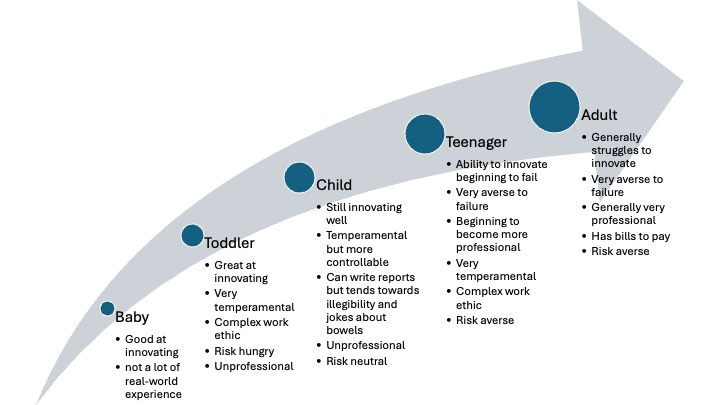So many decisions in business are made through the lens of a maturity model. The maturity model says that first that we do this thing, then another thing, then another thing, and in 5 to 15 years we’ll have built a strong enough base to run an AI project. Can we accelerate things? The maturity model says no. Can we change course? The maturity model says no. Should we just keep doing exactly what we’re doing? The maturity model says YES.
What is this? This is The Dots, our newsletter about exciting things we find in the world of innovation. We imagine innovation as connecting the dots; putting together a jigsaw. Our puzzle pieces are the pieces of interesting information we absorb in the world, our partners and their products. This newsletter is about these dots we find and connect.
Maturity Models
Maturity models are everywhere these days. With good reason too - they are a simple way of managing expectations and keeping folks focused on building strong foundations and preventing a robot uprising.
If you’re blessedly unaware of the maturity model trend then imagine an assessment combined with a roadmap and that’s what we’re talking about. You can use the assessment to determine where you are on the roadmap and to see what your next steps should be. Maturity models are often notable for their egregious use of PowerPoint’s Smart Art, frequently using the big ‘swoosh arrow’.
It can be useful to assess your data maturity or your security maturity or countless other maturities. You can see how far you’ve come, what you need to do reach the next level and what you’re ultimately aiming for all in one neat diagram. If your board suggest that you should be taking advantage of AI across your entire business you can point at the data maturity model and explain that no, you need to walk before you can run - your data quality needs to be good before you can even think about exciting AI models. If you need investment to reduce your cybersecurity risk then a maturity model is a great way to show your investors where you are heading, what that will mean and why you need all that money.
A maturity model is a plan and there is comfort and security in planning. You know where you are going. There are no great leaps into the unknown. That scary futuristic stuff is three whole swoops of the arrow away... the steps between now and there are, in fact, so incredibly enormous that it doesn’t seem likely that we’ll ever even have to get there. That’s nice... we can just rest here in the comfort of sorting our data quality issues and rolling out PowerBI to a select few individuals...
Wait... why is everyone leaving? You’re bored? What? What do you mean our competitor is doing something with robotics? What fools - they can’t have sorted out all their business processes yet!
Many of the big consultancies will tell you that you should not progress to the next stage of the maturity model until you’ve completed this one. That might work great for Deloitte and PwC but what if it’s holding you back? Or worse, what if it’s holding the brilliant, creative, innovative people in your business?
You are no doubt surprised to hear that we believe that it is far too easy to end up shackled to your maturity model. Using it to provide direction is great but too stringently enforcing your maturity-model-defined focus means you won’t ever have the permission to do something new, exciting or innovative. A maturity model, by it’s very existence, means that you’re a follower not a leader.
We’re not saying you should throw it all away - you need a plan, it’s useful, but it’s not the be all and end all of everything. To use the parlance of our times, it might be your main quest but sometimes it’s fun to get distracted by that shiny side quest over there. You’re allowed to take a cheeky trip to the end just to see what it’s like as long as you don’t cause chaos right now.
Many of the big consultancies will tell you that you should not progress to the next stage of the maturity model until you’ve completed this one. That might work great for Deloitte and PwC but what if it’s holding you back? Or worse, what if it’s holding the brilliant, creative, innovative people in your business?
If you want to run a robotics trial in your organisation you can do that right now. It might not be the biggest trial, it might even be just a trip to go and see someone else who is using robots in their processes. But you can probably do it next week. You don’t have to wait for the end of the robotics maturity model to do it just get on with it.
We’re not saying you should let the pendulum swing all the way back to chaotic autonomy - your adventure to the end needs to be considered. Think about how you mitigate and work around the risks. Start with the smallest, most exciting step. Keep it separate and self-contained. And let people get on with doing the good foundational work that they’re doing right now.
You see, we’re not anti-plan. We’re anti-not doing stuff and we’re anti-boring. If you’re shutting down exciting ideas in the name of the maturity model then you owe it to your people to at least see whether you can take a cheeky little shortcut to the end to try something out.
ICYMI
This week, Frankie has written an article about AI and how it may affect (or not affect) software engineers: read it here
What would you do if you had permission to ignore your business’s maturity model? You know what to do. 👇







